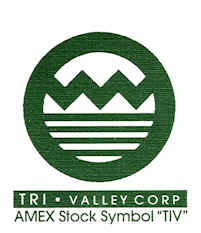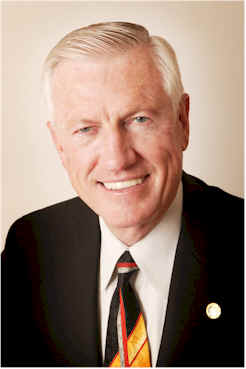CEOCFO-Members Login
Become A Member!
|
This is a printer friendly page!
Tri-Valley Corp. is focused on oil and gas exploration with their
headquarters located in the town of Bakersfield, California where the daily production is three time as much as the entire state of
Oklahoma or equals about 40% of the entire state of Texas’ daily production

Basic Materials
Oil & Gas Drilling & Exploration
(TIV-AMEX)
Tri-Valley Corp.
4550 California Avenue, Suite 600
Bakersfield, CA 93309
Phone: 661-864-0500

Mr. F. Lynn Blystone
Chairman, President and CEO
Interview conducted by:
Walter Banks, Publisher
CEOCFOinterviews.com
Published – July 20, 2007
BIO:
F. Lynn Blystone
CEO and President of Tri-Valley Corporation and CEO of its subsidiaries.
A director since 1974, Mr. Blystone assumed the role of Tri-Valley Corporation President
in October 1981. His background includes institution management, venture capital and
various management functions for a mainline pipeline contractor, including the
Trans-Alaska Pipeline Project. He has founded, managed and sold companies in several
fields including Learjet charter, commercial construction, municipal finance and land
development. He is also president of a family corporation, Bandera Land Company, Inc.,
with real estate interests in Orange County, California. Mr. Blystone is a graduate of
Whittier College, California, and did graduate work at George Williams College, Illinois,
in organization management.
Company Profile:
Tri-Valley Corporation offers investors a way to access and participate in big upside oil,
gas and mineral exploration, discoveries and development projects. Most of its projects
are high risk / high reward type that can add exponential value to the stock on discovery
and production success.
CEOCFO: Mr. Blystone, how long have you been with
Tri-Valley Corporation and what changes have take place since you have been CEO?
Mr. Blystone: “It is Tri-Valley
Corporation’s 45th year of business. I have been president and CEO since
1981 and, most of those years have not been kind to the industry, but we are only just now
having some enjoyment. Since it is now a very positive time for the energy business and we
have positioned ourselves to benefit from that resurgence, we think we can offer an
uncommon opportunity for people interested in investing in the energy business. We
primarily explore for and produce oil and gas primarily in California, but we do have some
properties in Nevada. We also have our own drilling subsidiaries so that we are not
dependent on contractors to supply either production rigs for servicing our wells or
drilling rigs to drill our wells. We have another division for mineral exploration and
production, which includes large gold exploration projects in Alaska, with about sixty
square miles of claims in areas where we have actually found gold. We are in the process
of measuring what we found and we have a world-class calcium carbonate deposit also in
Alaska. We are a resource company. We are also taking old oil fields that have never had
modern technology applied to them and re-exploiting these oil fields to get additional
production.”
CEOCFO: Is that your primary model?
Mr. Blystone: “Applying new technology is just
one of the things that we do as we acquire these properties and we re-exploit them. For
example, we have a heavy oil property down by Oxnard, just south of Ventura, California
and this property has never had any horizontal drilling or steam application put to it.
Therefore, we think that we have an enormous resource there that has been overlooked by
the industry for many years because the price was low. Now the price is high and we have
modern technology that we can apply to the field to get an extraordinary amount of oil
back.”
CEOCFO: Why have you chosen California as the target of your
efforts?
Mr. Blystone: “Most people do not know there is
oil west of the Rockies. In fact, just the area around our headquarters town of
Bakersfield California, the daily production is three times as much as the entire state of
Oklahoma or it equals about 40% of the entire state of Texas’ daily production. This
is a wonderful place to look for really big targets. There are four fields right here that
have produced over a billion barrels and 22 that have produced over 100 million barrels.
Most of this is from 12,000 feet and above, but in the Great Central Valley here, the
sediments go down to 45,000 feet before they hit basement. Two thirds of this area has not
even been explored on a vertical basis let alone the aereal extent. It is a wonderful
place to look for additional oil strikes. With all these big fields still producing after
more than 100 years, there are many existing properties that we can pick up and re-exploit
with new technology”
CEOCFO: Do you have to fight the local government and the
people to be able to do exploration in these areas of California
Mr. Blystone: “We have been able to explore here for
45 years, so we know the rules and regulations and if you pay attention to the business,
you seldom have any problems in that regard. Obviously if you are going to drill in a
residential area, you are going to meet some opposition. The industry has new techniques,
such as horizontal drilling where you can position the well a mile away from where we want
to bottom out and sometimes that allows us to be away from the areas we really want to
target. There are tens of thousands of wells around Bakersfield, California, so the
community is used to it and most of the people in the Valley are used to it. This is a
gigantic agricultural area so there are enormous swaths of land that have no
infrastructure on them and we can usually negotiate with the farmers to get a drill site
and pay them for their crop loss and go from there. They say the best farms are the ones
that have oil wells between the grape and cotton rows.”
CEOCFO: Are you currently only in exploration and
development or are you actually selling and moving product?
Mr. Blystone: “Along with our exploration, we
sell and move product as well. For example, we have a property that we recently acquired
on the flank of the South Belridge oil field, which is the nation’s third highest
producing oil field outside of Alaska. We are beginning to re-exploit this property with
modern technology. We will be drilling horizontal wells and putting steam in the
formations to accelerate the production and we will build the production to several
thousand barrels a day just from that one property.”
CEOCFO: You mentioned you have acreage in Nevada; how is
that going?
Mr. Blystone: “We have about 17,000 acres that we
have selected for exploration, but another thing that is giving us some interest is the
geothermal potential of several areas in Nevada. Geothermal is coming into its own now as
a source of power generation for electricity and we currently own the only Nevada based
drilling rig. It is now under contract drilling for geothermal resource by another
company, but we are giving serious thought to starting a geothermal division since we have
our own rig and experienced people to drill for those.
CEOCFO: What made you decide to get into metals?
Mr. Blystone: “We got into that in the
mid-1980’s when the oil prices were taking a hit and gold prices were still high, so
we got into it as a means of affording to stay in the oil business. We started finding
gold. However, shortly after we got into the gold business, the gold prices went
down as well, but we were finding so much opportunity that we just decided to stay in it.
Eventually the gold prices have come back so it has allowed us to accelerate the
exploration of these big areas. Alaska is now showing up as a place where giant mines can
be found; you have the Donlin Creek deposit, 70% owned by Nova Gold Resources Inc. (AMEX,
TSX: NG) with 25 million ounces and the Pebble deposit, owned by Northern Dynasty Minerals
Ltd. (NDM-TSX or NAK-AMEX) with 20 plus million ounces. Fort Knox, owned by Kinross Gold
Corporation (KGC: NYSE) has about 7 million ounces and the Pogo gold deposit, discovered
by Sumitomo Metal Mining America Inc., has about 7 million ounces. Since, they are our
neighbors, we have high hopes for eventually connecting enough dots to make a very large
mine and a good gold mine is just as good a moneymaker and valued added for shares as a
good oil field is.”
CEOCFO: Are you currently moving product in the metals as
well?
Mr. Blystone: “No, they are all really big
exploration projects and we are not that large a company. Therefore, we have to ration our
capital and it moves a little slower than it would if we were a major company
concentrating just on minerals.”
CEOCFO: Do you have the relationships necessary as you find
more oil to move it out into the public arena?
Mr. Blystone: “Oh absolutely! We have an
extremely powerful group of high net-worth partners that support our drilling and
re-exploitation efforts. We have made some private placements of our stock and we have
about $20 million in cash now and an opportunity to double that shortly. We have never
gone to a public offering beyond the fact that we are public and traded on the AMEX. We
have been careful to limit the amount of stock that we do issue so that we do not dilute
the shareholders unnecessarily. However, we have steadily added value and increased our
market share hundreds of times over the last few years. We have outperformed every stock
index that there is in eight of the last ten years. We climbed from about number 397 in
the oil and gas annual list of top US petroleum companies in 1982 to March 8, 2007, when I
looked at it, where we are number 106. Therefore, we have made steady progress over that
period. We are a growth company both in terms of the size and more importantly in terms of
the value of the stock. We have rewarded our shareholders exceptionally along the way and
that is our mission statement, to simply add value and liquidity to our shares.”
CEOCFO: Where do you see future growth coming from the
company?
Mr. Blystone: “We see future growth coming from
accretive efforts as we are looking at other companies and properties to acquire, as well
as from success with the drill bit and the exploration side of the business. We think that
we can continue to grow at an exceptional rate as we have in the past so that people going
for a ride with us are going to get there faster than if they were with someone
else.”
CEOCFO: In closing, there is a lot of competition for
finding oil, what gives you an edge in the exploration department; is it your managing
team, technology, common sense?
Mr. Blystone:
“We own a proprietary database, which generally gives us data on every continent
except Antarctica, but more specifically, we have about 700 leads and prospects in
California alone. California is our playground and we have very little competition here.
We are the main player in many of these areas. Our 45 years of experience gives us a
tremendous edge over someone coming in. Further, that edge is in every facet of the
industry, whether it is the exploration or permitting aspects, and with our drill rigs
being able to drill at will instead of twiddling our thumbs for a year and a half waiting
for the contractor to give us a rig. We have excellent high-quality technical people on
our staff and good solid managers that are experienced in running a public full reporting
company and meeting investor expectations.”
disclaimers
Any reproduction or further distribution of this
article without the express written consent of CEOCFOinterviews.com is prohibited.
|


